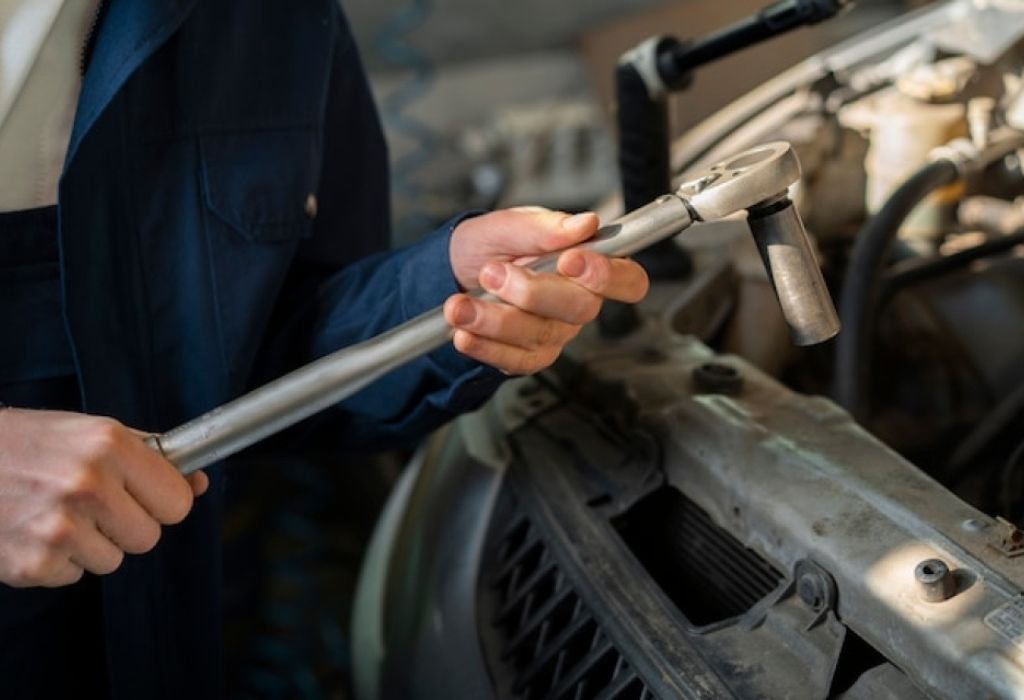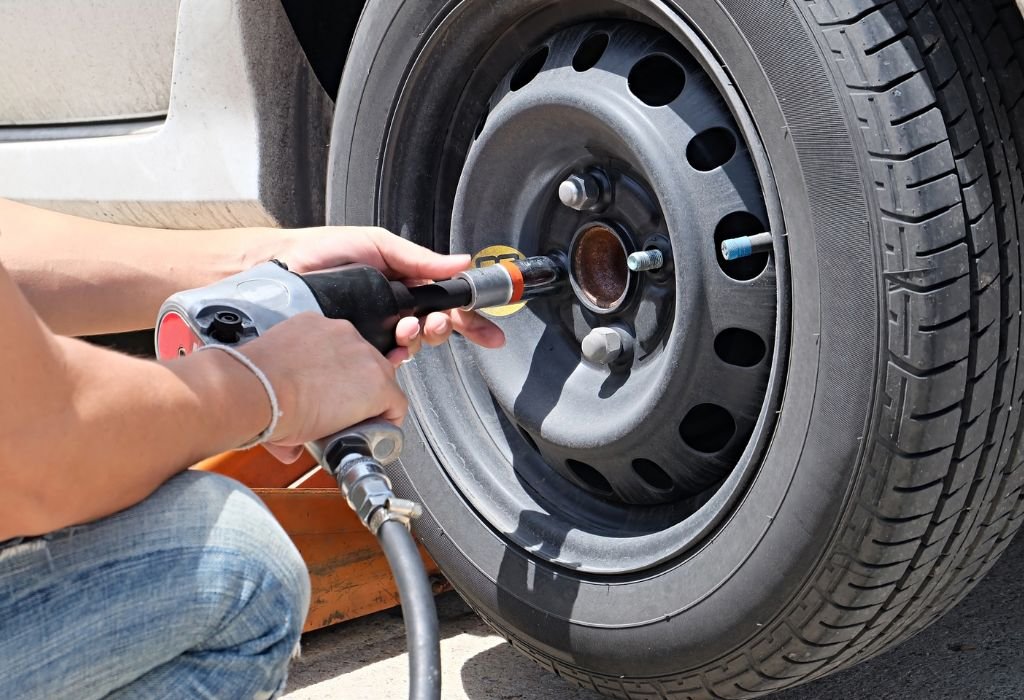Picture this: you’re on the side of the road with a flat tire, and the only power tool in your trunk is an impact driver. You wonder, “Can this tool actually remove my car’s lug nuts?”
It’s a fair question, especially since impact drivers are compact, powerful, and incredibly popular for DIY and construction. However, lug nuts are a different challenge altogether—they are tightened with significant torque and often resist removal if over-tightened or rusted.
Most passenger car lug nuts require 80–120 ft-lbs of torque to be properly removed. Trucks and SUVs often need 100–140 ft-lbs or more, and in some cases, rust or overtightening can push this requirement even higher.
So, can an impact driver—whether a ¼-inch, a cordless model, or a DeWalt 20V—actually remove lug nuts? This guide will break down the torque requirements, the mechanics of impact drivers, real-world performance, and when it’s time to reach for the right tool: the impact wrench.
How Much Torque Do You Need to Remove Lug Nuts?

Torque is the twisting force that allows a tool to loosen or tighten fasteners. Lug nuts are designed to hold wheels securely in place, so they require significant torque to remove.
- Passenger cars: typically need between 80–100 ft-lbs
- SUVs and light trucks: usually fall between 100–140 ft-lbs
- Heavy-duty trucks: may need 160 ft-lbs or more
It’s important to note that torque specifications are given in foot-pounds (ft-lbs), but most impact drivers are rated in inch-pounds (in-lbs). Since 1 ft-lb = 12 in-lbs, a driver rated at 1,800 in-lbs actually delivers 150 ft-lbs of torque.
However, real-world performance depends not only on rated torque but also on factors like battery charge, socket adapters, and the condition of the lug nut. Overtightened, cross-threaded, or rusted nuts may require much more than the tool’s maximum rating.
How an Impact Driver Works
An impact driver is designed for high-torque fastening tasks. It uses a hammer-and-anvil mechanism that delivers rapid, concussive rotational bursts. These bursts increase torque while reducing strain on the user’s wrist.
- ¼-inch hex collet: impact drivers hold hex-shank bits or adapters.
- Torque output: typically ranges from 1,000 to 2,000 in-lbs (≈ 85–165 ft-lbs) for 18V/20V models.
- IPM (impacts per minute): describes how many torque bursts occur each minute.
- RPM (rotations per minute): measures how fast the bit spins.
This design makes impact drivers excellent for driving long screws and bolts into wood or metal. However, lug nuts present a challenge because they often require torque at the very limit of what a compact driver can deliver.
Can a ¼-Inch Impact Driver Remove Lug Nuts?
A ¼-inch impact driver is the most common type, but it is not ideal for lug nuts. The small hex collet limits the tool to hex-shank bits, so you’ll need a socket adapter to fit lug nut sockets.
While a ¼-inch driver may generate enough torque on paper, there are limitations:
- Adapter stress: socket adapters can snap or twist under high torque.
- Inconsistent torque: drivers may stall on overtightened nuts.
- Risk of stripping: without proper adapters, sockets may slip and damage nuts.
In practice, a ¼-inch impact driver can remove lug nuts that are tightened within normal torque specs (80–100 ft-lbs). But if the nuts are overtightened, rusted, or on larger vehicles, the driver may not have enough power.
Can a Cordless Impact Driver Remove Lug Nuts?

Cordless impact drivers are powerful, but results vary by battery voltage and tool quality.
- 12V models: too weak, rarely exceed 900 in-lbs (~75 ft-lbs). Not suitable for lug nuts.
- 18V/20V models: more powerful, often rated between 1,400–1,800 in-lbs (≈117–150 ft-lbs). These can handle many car lug nuts but may fail on tougher ones.
- 24V models: less common, but capable of slightly higher torque.
Brushless motors improve efficiency and runtime, giving cordless drivers more real-world power. Still, cordless impact drivers are not designed with lug nuts in mind.
Yes, a good cordless impact driver can remove lug nuts, especially on passenger cars. But it may struggle with trucks or overtightened nuts.
Can a DeWalt 20V Impact Driver Remove Lug Nuts?
DeWalt’s 20V MAX impact driver is one of the most popular models on the market. Depending on the version, it produces between 1,400 and 1,825 in-lbs of torque—that’s about 117–152 ft-lbs.
This means a DeWalt 20V can remove most passenger car lug nuts under normal conditions. In fact, many users report success with this tool when changing tires or doing light automotive work.
However, limitations remain:
- Overtightened nuts: if a shop used a pneumatic wrench, torque could exceed 150 ft-lbs.
- Rusted bolts: corrosion can increase resistance, making removal harder.
- Trucks/SUVs: higher torque specs may exceed the tool’s capacity.
For consistent automotive work, DeWalt also makes 20V impact wrenches with ½-inch drives, designed specifically for lug nuts. These deliver far higher torque (up to 700+ ft-lbs).
So yes—a DeWalt 20V impact driver can remove lug nuts in many cases. But for reliability, an impact wrench is the better tool.
Impact Driver vs Impact Wrench for Lug Nuts
It’s important to clarify the difference between these two tools.
- Impact Driver
- ¼-inch hex collet
- Torque: 1,000–2,000 in-lbs (85–165 ft-lbs)
- Best for: screws, bolts, light automotive tasks
- Pros: compact, lightweight, versatile
- Cons: not reliable for tough lug nuts
- Impact Wrench
- ½-inch square drive
- Torque: 200–1,000+ ft-lbs
- Best for: automotive, industrial fasteners, heavy-duty bolts
- Pros: extremely powerful, designed for lug nuts
- Cons: heavier, bulkier, more expensive
Quick Comparison Table
| Feature | Impact Driver | Impact Wrench |
| Drive Type | ¼-inch hex collet | ½-inch square drive |
| Torque Range | 85–165 ft-lbs | 200–1,000+ ft-lbs |
| Best Use | Screws, light bolts | Lug nuts, heavy bolts |
| Size & Weight | Compact, lightweight | Larger, heavier |
| Automotive Use | Occasional, light-duty | Professional, heavy-duty |
Tips for Using an Impact Driver on Lug Nuts

If you plan to use an impact driver for lug nuts, keep these tips in mind:
- Use impact-rated socket adapters – standard adapters may break under torque.
- Fully charge the battery – cordless models need maximum voltage for tough nuts.
- Break overtightened nuts manually first – use a breaker bar if possible.
- Don’t use for final tightening – always use a torque wrench to ensure nuts are tightened to spec.
- Check your tool’s rating – confirm that your driver produces at least 120 ft-lbs of torque.
- Use short, impact-rated sockets – deep sockets or non-impact sockets may absorb torque.
FAQs
1. Can an impact driver break loose lug nuts?
Yes, if the nuts are tightened within normal torque specs (80–120 ft-lbs). But for overtightened or rusted nuts, it may not be enough.
2. Can a ¼-inch impact driver remove lug nuts?
Only with a socket adapter, and only for moderately tight nuts. It’s not reliable for overtightened or rusted ones.
3. Can a cordless impact driver remove lug nuts?
Yes, 18V/20V cordless models can remove many car lug nuts. 12V models are usually too weak.
4. Can a DeWalt 20V impact driver remove lug nuts?
Yes, most car lug nuts fall within its torque range (117–152 ft-lbs). But it may struggle with trucks or seized nuts.
5. Do I need an adapter to use an impact driver for lug nuts?
Yes, you need a ¼-inch hex to ½-inch square drive adapter to attach sockets.
6. Can an impact driver replace an impact wrench?
No. Impact drivers are not designed for consistent lug nut work. An impact wrench is the proper tool.
7. What torque is required for lug nuts?
Most cars: 80–100 ft-lbs. Trucks/SUVs: 100–140 ft-lbs or more.
8. Can I tighten lug nuts with an impact driver?
Not recommended. Use a torque wrench to ensure proper tightening without over-torquing.
9. Which tool should I buy first for automotive work?
An impact wrench is best for lug nuts. An impact driver is better for general DIY and woodworking.
10. Will a 12V impact driver remove lug nuts?
No, 12V models typically max out around 75 ft-lbs, which is below the requirement for most vehicles.
11. What’s the difference between impact driver torque in in-lbs and ft-lbs?
Divide in-lbs by 12 to convert to ft-lbs. Example: 1,800 in-lbs = 150 ft-lbs.
12. Is it safe to use an adapter with an impact driver?
Yes, but only if it’s impact-rated. Cheap adapters may break under load.
13. Can an impact driver damage lug nuts?
Yes, if the adapter slips or if used for tightening without a torque wrench.
14. Are impact drivers good emergency tools for flat tires?
Yes, they can help in emergencies if properly equipped. But keep a breaker bar as backup.
15. Do mechanics use impact drivers for lug nuts?
No, professionals use impact wrenches designed specifically for automotive work.
Conclusion
So, can you use an impact driver to remove lug nuts? The answer is sometimes.
A strong 18V/20V cordless impact driver, like the DeWalt 20V, can remove many passenger car lug nuts under normal torque specs. However, it may fail on overtightened, rusted, or truck lug nuts.
A ¼-inch impact driver with a socket adapter can work, but it’s not reliable or safe for regular automotive use. For consistent, heavy-duty performance, an impact wrench with a ½-inch square drive is the right tool.
If you’re a DIYer, an impact driver is an excellent tool for construction, woodworking, and occasional lug nut emergencies. But if you plan to work on vehicles regularly, investing in a proper impact wrench will save you time, effort, and frustration.

I’m John F. Nicholas, the founder, lead writer, and drill enthusiast behind 101drill.com. With years of hands-on experience in power tools and DIY projects, I created this platform to share practical knowledge, expert tips, and real-world insights to help others master the art of drilling.
